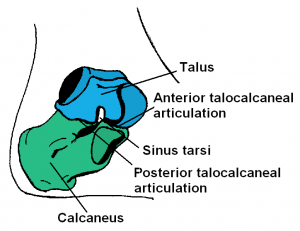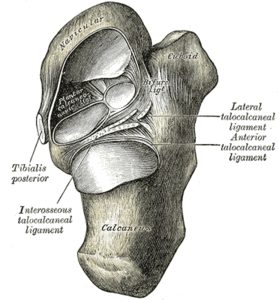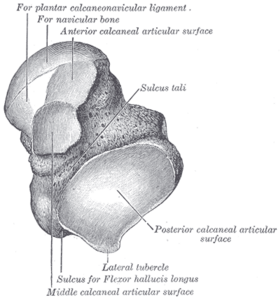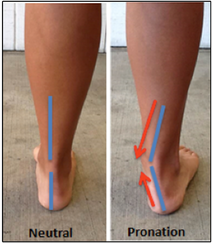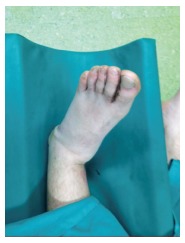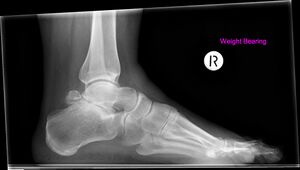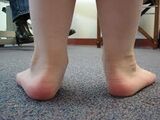Subtalar Joint
Original Editor - Lucinda hampton
Top Contributors - Lucinda hampton, Vidya Acharya, Abbey Wright and Kim Jackson
Introduction[edit | edit source]
The subtalar (ST) joint is an articulation between two of the tarsal bones in the foot, the talus and calcaneus. The joint is classed structurally as a synovial joint, and functionally as a plane synovial joint[1].
The ST joint allows the foot side-to-side (inversion/eversion), pivot to change directions, and stay balanced as we move across uneven terrain. Without this joint, a person would constantly roll their ankles when running, jumping, or walking.
Structure[edit | edit source]
The ST joint is multi-articular joint, with three articulated facets that provide a surface for the joint to glide:
- The anterior subtalar joint : Allows joint to glide forward (anterior articulation)
- The medial subtalar joint: Allows joint to glide side-to-side (eversion/inversion)
- The posterior subtalar joint: Allows the to glide backward (posterior articulation)
The talus and calcaneous bones are held in place by strong but flexible connective ligaments. The main ligament that attaches these bones is called the interosseous talocalcaneal ligament. Four other weaker ligaments provide the joint with added stability[2]. The interosseous talocalcaneal ligament, acts to bind the talus and calcaneus together. It lies within the sinus tarsi (a small cavity between the talus and calcaneus), and is particularly strong; providing the majority of the ligamentous stability to the joint[1][3].
In between the calcaneus and talus is the synovial membrane. This tissue secretes fluid to lubricate the joint space, protecting the cartilage and bones from damage.
Movements[edit | edit source]
The movements that occur at the subtalar joint are gliding and rotation.The combination of these movements result in pronation and supination; these are considered to be the primary movements in the subtalar joint. They are always accompanied by movements in the talocalcaneonavicular and calcaneocuboid joints and as such these three joints are considered to be one functional unit of the foot.[3][1].
- Supination in the subtalar joint is primarily produced by tibialis anterior and tibialis posterior, with assistance from extensor hallucis longus, flexor hallucis longus and flexor digitorum longus.
- Pronation is mainly produced by fibularis longus, fibularis brevis and fibularis tertius with assistance from the extrinsic muscles that extend the toes (extensor digitorum longus and extensor hallucis longus)[3].
Function[edit | edit source]
The ST joint is key to many functional activities eg walking and running, and posture while performing these tasks. The mechanisms behind how the subtalar joint propels you us is very complex.
This ST joints primary movements involve supination, in which the foot rolls toward the body's midline, and pronation, in which the foot rolls away from the midline. Both of these movements require a combination of distinct actions.
- Pronation requires a combination of dorsiflexion, abduction, and eversion.
- Supination requires a combination of plantar flexion, adduction and inversion[2]
Physiotherapy Relevance[edit | edit source]
The subtalar joint is essential for mobility, and as such is prone to wear and tear, trauma, and joint-specific disorders. Any damage done to the subtalar joint and surrounding soft tissues that support it may lead to pain, and foot deformity (often permanent), and affect gait and mobility. Conditions affecting this joint include the below:
Directly Joint Related
- Juvenile Rheumatoid Arthritis: The subtalar joint is often the first joint affected
- Osteoarthritis: eg Calcaneal fracture (subtalar joint is usually disrupted, causing the joint to become arthritic)[1].
- Rheumatoid arthritis: Primarily attacks joint tissues, often the ankle and foot[2]
Disorders in which the subtalar joint is indirectly affected or affected as a result of another defect or injury to the foot or ankle. Include:
- Pes cavus/Pes planus
- Subtalar dislocation occurs through the disruption of 2 separate bony articulations, the talonavicular and talocalcaneal joints
- Chronic Ankle Instability
- Tarsal coalition[2]
- Sinus tarsi syndrome
References[edit | edit source]
- ↑ 1.0 1.1 1.2 1.3 Teach me anatomy The subtalar loint Available:https://teachmeanatomy.info/lower-limb/joints/subtalar/ (accessed 5.6.2022)
- ↑ 2.0 2.1 2.2 2.3 Very well health Subtalar joint Available: https://www.verywellhealth.com/what-is-the-subtalar-joint-1337686(accessed 5.6.2022)
- ↑ 3.0 3.1 3.2 Kenhub Subtalar joint Available: https://www.kenhub.com/en/library/anatomy/subtalar-joint(accessed 5.6.2022)
